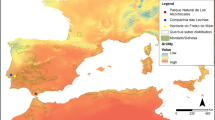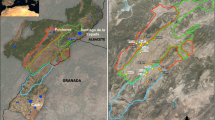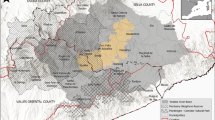Abstract
In many developing countries, political documentation acknowledges the crucial elements of participation and spatiality for effective land use planning. However, operative approaches to spatial data inclusion and representation in participatory land management are often lacking. In this paper, we apply and develop an integrated landscape characterization approach to enhance spatial knowledge generation about the complex human–nature interactions in landscapes in the context of Zanzibar, Tanzania. We apply an integrated landscape conceptualization as a theoretical framework where the expert and local knowledge can meet in spatial context. The characterization is based on combining multiple data sources in GIS, and involves local communities and their local spatial knowledge since the beginning into the process. Focusing on the expected information needs for community forest management, our characterization integrates physical landscape features and retrospective landscape change data with place-specific community knowledge collected through participatory GIS techniques. The characterization is established in a map form consisting of four themes and their synthesis. The characterization maps are designed to support intuitive interpretation, express the inherently uncertain nature of the data, and accompanied by photographs to enhance communication. Visual interpretation of the characterization mediates information about the character of areas and places in the studied local landscape, depicting the role of forest resources as part of the landscape entity. We conclude that landscape characterization applied in GIS is a highly potential tool for participatory land and resource management, where spatial argumentation, stakeholder communication, and empowerment are critical issues.







Similar content being viewed by others
References
Antrop M (2003) The role of cultural values in modern landscapes. The Flemish example. In: Palang H, Fry G (eds) Landscape interfaces: cultural heritage in changing landscapes. Kluwer Academic Publishers, Dordrecht, pp 91–108
Antrop M (2006) From holistic landscape synthesis to transdisciplinary landscape management. In: Tress B, Tress G, Fry G, Opdam, P (eds) From landscape research to landscape planning: aspects of integration, education and application, vol 12, Springer, Dordrecht, Berlin, Heidelberg, pp 13–26
Apan AA (1996) Tropical landscape characterisation and analysis for forest rehabilitation planning using satellite data and GIS. Landsc Urban Plan 34:45–54
Bishop K, Phillips A (eds) (2004) Countryside planning: new approaches to management and conservation. Earthscan, London, p 269
Blankson EJ, Green HB (1991) Use of landscape classification as an essential prerequisite to landscape evaluation. Landsc Urban Plan 21:149–162
Bocco G, Mendoza M, Velázquez A (2001) Remote sensing and GIS-based geomorphological mapping—a tool for land use planning in developing countries. Geomorphology 39:211–219
Bohnet I, Smith DM (2007) Planning future landscapes in the wet tropics of Australia: a social-ecological framework. Landsc Urban Plan 80:137–152
Bourgoin J, Castella J-C, Pullar D, Lestrelin G (2012) Toward a land zoning negotiation support platform: ‘tips and tricks’ for participatory land use planning in Laos. Landsc Urban Plan 104:270–278
Brink AB, Eva HD (2009) Monitoring 25 years of land cover change dynamics in Africa: a sample based remote sensing approach. Appl Geogr 29:501–512
Brown G (2005) Mapping spatial attributes in survey research for natural research management: methods and applications. Soc Nat Resour 18:17–39
Brown G, Pullar D (2011) An evaluation of the use of points versus polygons in public participation geographic information systems using quasi-experimental design and Monte Carlo simulation. Int J Geogr Inf Sci 1:1–16
Burgess ND, Clarke GP (eds) (2000) Coastal forests of eastern Africa. IUCN—The World Conservation Union. Cambridge and Gland, IUCN, pp 443
Campos M, Velázquez A, Bocco G, Boada M, Guadalupe Á (2010) Defining environmental management units based upon integrated socio-economic and biophysical indicators at the pacific coast of Mexico. Interciencia 35:33–40
Chapin M, Lamb Z, Threlkeld B (2005) Mapping indigenous lands. Annu Rev Anthropol 34:619–638
Chuman T, Romportl D (2010) Multivariate classification analysis of cultural landscapes: an example from the Czech Republic. Landsc Urban Plan 98:200–209
Corbett J, Rambaldi G (2009) Geographic information technologies, local knowledge, and change. In: Cope M, Elwood S (eds) Qualitative GIS: a mixed methods approach. Sage, London, pp 75–91
Cortina-Villar S, Plascencia-Vargas H, Vaca R, Schroth G, Zepeda Y, Soto-Pinto L, Nahed-Toral J (2012) Resolving the conflict between ecosystem protection and land use in protected areas of the Sierra Madre de Chiapas, Mexico. Environ Manage 49:649–662
Council of Europe (2000) The European Landscape Convention. http://conventions.coe.int/Treaty/en/Treaties/Html/176.htm. Accessed 22 Feb 2012
Craig WJ, Harris TM, Weiner D (eds) (2002) Community participation and geographic information systems. Taylor & Francis, London, p 383
Cullotta S, Barbera G (2011) Mapping traditional cultural landscapes in the Mediterranean area using a combined multidisciplinary approach: method and application in Mount Etna. Landsc Urban Plan 100:98–108
DCCFF (2008) Zanzibar National Forest Resources Management Plan (2008–2020). Department of Commercial Crops, Fruits and Forestry, Zanzibar, 70 pp
De Groot RS, Alkemade R, Braat L, Hein L, Willemen L (2010) Challenges in integrating the concept of ecosystem services and values in landscape planning. Ecol Complex 7:260–272
Duvail S, Hamerlynck O, Nandi RXL, Mwambeso P (2006) Participatory mapping for local management of natural resources in villages of the Rufiji district (Tanzania). Electron J Inf Syst Dev Ctries 25:1–6
Fagerholm N, Käyhkö N (2009) Participatory mapping and geographical patterns of the social landscape values of rural communities in coastal Zanzibar, Tanzania. Fennia 187:43–60
Fagerholm N, Käyhkö N, Ndumbaro F, Khamis M (2012) Community stakeholders’ knowledge in landscape assessments—mapping indicators for landscape services. Ecol Indic 18:421–433
Fairclough G, Lambrick G, Hopkins D (2002) Historical landscape characterisation in England and a Hampshire case study. In: Fairclough G, Rippon S, Bull D (eds) Europe’s cultural landscape: archaeologists and the management of change. Europae Archaeologiae Consilium, Brussels, pp 69–80
FAO (Food and Agriculture Organization of the United Nations) (2010) Global Forest Resources Assessment 2010—Main report. FAO Forestry Paper 163, pp 340
Flavelle A (2002) Community mapping handbook—mapping our land. Lionel Pine Publishing, Canada, p 204
Flintan, F (2012) Participatory rangeland resource mapping as a valuable tool for village land use planning in Tanzania. International Land Coalition publications, pp 19. http://www.landcoalition.org/sites/default/files/publication/1422/RangelandMappingReportTanzania.pdf. Accessed 21 Dec 2012
Fox J, Suryanata K, Hershock P, Pramono AH (2006) Mapping power: ironic effects of spatial information technology. Particip Learn Action 54:98–105
Fry G, Tress B, Tress G (2007) Integrative landscape research: facts and challenges. In: Wu J, Hobbs RJ (eds) Key topics in landscape ecology. Cambridge University Press, Cambridge, pp 246–268
Granö O, Paasi A (eds) (1997) Pure geography—Johannes Gabriel Granö. Johns Hopkins University Press, Baltimore, London, p 191
Groom G, Wascher D, Potschin M, Haines-Young R (2006) Landscape character assessments and fellow travellers across Europe. In: Bunce RGH, Jongman RHG (eds) Landscape ecology in the Mediterranean: inside and outside approaches. Proceedings of the European IALE Conference, 29 March–2 April 2005, Faro, Portugal. IALE Publication Series 3, pp 221–231
Haines-Young RH (1992) The use of remotely sensed imagery for landscape classification in Wales (U.K.). Landsc Ecol 7:253–274
Haines-Young R, Potschin M (2010) The links between biodiversity, ecosystem services and human well-being. In: Raffaelli DG, Frid CLJ (eds) Ecosystem ecology: a new synthesis. University Press, Cambridge, pp 110–139
Haines-Young R, Langanke T, Potschin M (2007) Landscape character as a framework for the assessment of environmental change. In: Petrosillo I, Müller F, Jones KB, Zurlini G, Krauze K, Victorov S, Li B-L, Kepner WG (eds) Use of landscape science for the assessment of environmental security. Springer, Dordrecht, pp 159–168
Hartter J, Lucas C, Gaughan AE, Aranda LL (2008) Detecting tropical dry forest succession in a shifting cultivation mosaic of the Yucatán Peninsula, Mexico. Appl Geogr 28:134–149
Hettige ML (1990) Land evaluation and land suitability classification—Unguja & Pemba Island. Food Agric Organ U. N., pp 142
Jellema A, Stobbelaar D-J, Groot JCJ, Rossing WAH (2009) Landscape character assessment using region growing techniques in geographical information systems. J Environ Manage 90:5161–5174
Käyhkö N, Skånes H (2006) Change trajectories and key biotopes—assessing landscape dynamics and sustainability. Landsc Urban Plan 75:300–321
Käyhkö N, Fagerholm N, Asseid BS, Mzee AJ (2011) Dynamic land use and land cover changes and their effects on forest resources in a coastal village of Matemwe, Zanzibar, Tanzania. Land Use Policy 28:26–37
Käyhkö N, Fagerholm N, Mzee AJ (submitted) Local farmers’ place-based forest benefits and government interventions behind land cover and forest transitions in Zanzibar, Tanzania
Kim K-H, Pauleit S (2007) Landscape character, biodiversity and land use planning: the case of Kwangju City Region, South Korea. Land Use Policy 24:264–274
Kyem PAK (2001) Power, participation, and inflexible institutions: an examination of the challenges to community empowerment in participatory GIS applications. Cartographica 38:5–18
Lambin EF, Meyfroidt P (2010) Land use transitions: socio-ecological feedback versus socio-economic change. Land Use Policy 27:108–118
Lambin EF, Turner BL, Geist HJ, Agbola SB, Angelsen A, Bruce JW, Coomes OT, Dirzo R, Fischer G, Folke C, George PS, Homewood K, Imbernon J, Leemans R, Li X, Morano EF, Mortimore M, Ramakrishnan PS, Richards JF, Skånes H, Steffen W, Stone GD, Svedin U, Veldkamp TA, Vogel C, Xu J (2001) The causes of land-use and land-cover change: moving beyond the myths. Glob Environ Change 11:261–269
Lambin EF, Giest HJ, Lepers E (2003) Dynamics land use and land cover changes in tropical regions. Annu Rev Environ Resour 28:205–241
Lewis JL, Sheppard SRJ (2006) Culture and communication: can landscape visualization improve forest management consultation with indigenous communities. Landsc Urban Plan 77:291–313
Lofchie MF (1965) Zanzibar: background to revolution. Princeton University Press, New Jersey, p 316
Lörzing H (2001) The nature of landscape—a personal quest. 010 Publishers, Rotterdam, p 179
MacEachren AM (2004) How maps work: representation, visualisation and design, 2nd edn. The Guilford Press, New York, p 513
MacEachren AM, Robinson A, Hopper S, Gardner S, Murray R, Gahegan M, Hetzler E (2005) Visualizing geospatial information uncertainty: what we know and what we need to know. Cartogr Geogr Inf Sci 32:139–160
Mäki S, Kalliola R (2000) Visualization and communication in map-making: a case study of mapping a complex rainforest environment in Peruvian Amazonia. Cartographica 37:27–42
MANR (Ministry of Agriculture and Natural Resources) (2011) Community Forest Management Guidelines for the Development of Community Forest Agreements. RGZ (Revolutionary Government of Zanzibar), pp 76
McCall M (2006) Precision for whom? Mapping ambiguity and preciseness in (participatory) GIS. Particip Learn Action 54:114–119
MFEA (Ministry of Finance and Economic Affairs) (2010) The Economic Survey 2009. The United Republic of Tanzania. http://www.tanzania.go.tz/economicsurveyf.html. Accessed 14 Jun 2011
Mücher CA, Klijn JA, Wascher DM, Schaminée JHJ (2010) A new European landscape classification (LANMAP): a transparent, flexible and user-oriented methodology to distinguish landscapes. Ecol Indic 10:87–103
Mustalahti I, Bolin A, Boyd E, Paavola J (2012) Can REDD+ reconcile local priorities and needs with global mitigation benefits? Lessons from Angai forest Tanzania. Ecol Soc 17:16
Nassauer JI (1995) Culture and changing landscape structure. Landsc Ecol 10:229–237
Naveh Z (2001) Ten major premises for a holistic conception of multifunctional landscapes. Landsc Urban Plan 57:269–284
Oba G, Kaitira LM (2006) Herder knowledge of landscape assessments in arid rangelands in northern Tanzania. J Arid Environ 66:168–186
OCGS (Office of Chief Government Statistician) (2010) Zanzibar Statistical Abstract 2009. Zanzibar, pp 97
Opdam P, Steingröver E, van Rooj S (2006) Ecological networks: a spatial concept for multi-actor planning of sustainable landscapes. Landsc Urban Plan 75:322–332
Palang H, Fry G (2003) Landscape interfaces: introduction. In: Palang H, Fry G (eds) Landscape interfaces: cultural heritage in changing landscapes. Kluwer Academic Publishers, Dordrecht, pp 1–13
Potschin M, Haines-Young R (2006) “Rio + 10”, sustainability science and landscape ecology. Landsc Urban Plan 75:162–174
Rambaldi G (2010) Participatory three-dimensional modelling: guiding principles and applications. CTA, Wageningen, p 86
Reed MS (2008) Stakeholder participation for environmental management: a literature review. Biol Conserv 141:2417–2431
RGZ (Revolutionary Government of Zanzibar) (2004) State of the Environment Report of Zanzibar. Zanzibar, pp 38
Roba HG, Oba G (2009) Community participatory landscape classification and biodiversity assessment and monitoring of grazing lands in northern Kenya. J Environ Manage 90:673–682
Selman P (2006) Planning at the landscape scale. Routledge, Abingdon, p 224
Sitari T (2005) Forestry in the community lifeworld in Unguja island, Zanzibar. In: Sitari T (ed) Forestry, community and biodiversity in Zanzibar. Turku University Department of Geography Publications, Turku, pp 37–58
Soto S, Pintó J (2010) Delineation of natural landscape units for Puerto Rico. Appl Geogr 30:720–730
Stephenson J (2008) The cultural values model: an integrated approach to values in landscapes. Landsc Urban Plan 84:127–139
Swanwick C (2002) Landscape character assessment. Guidance for England and Scotland. Countryside Agency, Cheltenham and Scottish Natural Heritage, Edinburgh, pp 84
Termorshuizen JW, Opdam P (2009) Landscape services as a bridge between landscape ecology and sustainable development. Landsc Ecol 24:1037–1052
Törhönen M (2004) Sustainable land tenure and land registration in developing countries, including a historical comparison with an industrialised country. Comput Environ Urban Syst 28:545–586
Tress B, Tress G (2001) Capitalising on multiplicity: a transdisciplinary systems approach to landscape research. Landsc Urban Plan 57:143–157
UNEP (2007) Global environmental outlook 4. Progress, Malta, p 540
Valencia-Sandoval C, Flanders DN, Kozak RA (2010) Participatory landscape planning and sustainable community development: methodological observations from a case study in rural Mexico. Landsc Urban Plan 94:63–70
Van Eetvelde V, Antrop M (2009a) Indicators for assessing changing landscape character of cultural landscapes in Flanders. Land Use Policy 26:901–910
Van Eetvelde V, Antrop M (2009b) A stepwise multiscaled landscape typology and characterisation for trans-regional integration, applied on the federal state of Belgium. Landsc Urban Plan 91:160–170
Vervoort JM, Kok K, van Lammeren R, Veldkamp T (2010) Stepping into futures: exploring the potential of interactive media for participatory scenarios on social-ecological system. Futures 42:604–616
Wang J, Yang X (2012) A hierarchical approach to forest landscape pattern characterization. Environ Manage 49:64–81
Westerweld WG, Pedroli GBM, ven den Broek M, Spoek JM (1984) Classification in landscape ecology: an experimental study. Catena 11:51–63
Williams DR, Patterson ME (1996) Environmental meaning and ecosystem management: perspectives from environmental psychology and human geography. Soc Nat Resour 9:507–521
Williams AJ, Basha AU, Mtumwa SS, Mussa JM (1997) Cheju shehia forest management plan. Commision for Natural Resources, Forestry Technical Paper No. 95(i), Zanzibar, pp 30
Wood D (2010) Rethinking the power of maps. The Guilford, New York, p 334
Wu J, Hobbs RJ (eds) (2007) Key topics in landscape ecology. Cambridge University Press, Cambridge, p 297
Yao X, Jiang B (2005) Visualization of qualitative locations in geographic information systems. Cartogr Geogr Inf Sci 32:219–229
Zadeh LA (1965) Fuzzy sets. Inf Control 8:338–353
ZFDP (Zanzibar Forestry Development Project) (1997) Zanzibar long-term forestry plan 1997–2006. Technical Paper No. 72. Oy Edita Ab, Vantaa, Finland, pp 99
Zonneveld IS (1995) Land ecology. SPB Academic Publishing, Amsterdam, p 199
Zonneveld IS, Forman RTT (eds) (1990) Changing landscapes: an ecological perspective. Springer, New York, p 286
Zube EH (1987) Perceived land use patterns and values. Landscape Ecol 1:37–45
Acknowledgments
The authors wish to thank the community members of Cheju and Unguja Ukuu Kaebona for participating in the research, all the Finnish and Tanzanian members of the research project “Changing land use and forest management practices and multidimensional adaptation strategies in Zanzibar, Tanzania” (2010–2013), and the Department of Urban and Rural Planning (DoURP, formerly the Department of Survey and Urban Planning) in Zanzibar for allowing the use of spatial data. The research was funded by the Academy of Finland (Project 132819), the University of Turku, Department of Geography and Geology and the Laboratory of Computer Cartography (UTU-LCC), the Department of Forestry and Non-Renewable Natural Resources in Zanzibar, and the Department of Geography of Ghent University in Belgium.
Author information
Authors and Affiliations
Corresponding author
Rights and permissions
About this article
Cite this article
Fagerholm, N., Käyhkö, N. & Van Eetvelde, V. Landscape Characterization Integrating Expert and Local Spatial Knowledge of Land and Forest Resources. Environmental Management 52, 660–682 (2013). https://doi.org/10.1007/s00267-013-0121-x
Received:
Accepted:
Published:
Issue Date:
DOI: https://doi.org/10.1007/s00267-013-0121-x




